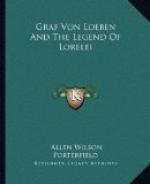Let us take up the various arguments in favor of the contention that Heine knew Schreiber’s Handbuch in 1823, beginning with the least convincing. If Heine read Loeben’s ballad and saga in “Urania fUer 1821,” he could thereby have learned also of Schreiber’s Rheinsagen, for, by a peculiar coincidence for our purpose, Brockhaus discusses[66] these in the introduction in connection with a tragedy by W. Usener, entitled Die BrUeder, and based upon one of Schreiber’s Sagen. Proof, then, that Heine knew Loeben in 1823 is almost proof that he also knew Schreiber.
But there is better proof than this. In Elementargeister[67], we find this sentence: “Ganz genau habe ich die Geschichte nicht im Kopfe; wenn ich nicht irre, wird sie in Schreibers Rheinischen Sagen aufs umstAendlichste erzAehlt. Es ist die Sage vom Wisperthal, welches unweit Lorch am Rheine gelegen ist.” And then Heine tells the same story that is told by Schreiber. It is the eighth of the seventeen Sagen in question. This, then, is proof that Heine knew Schreiber so long before 1835 that he was no longer sure he could depend upon his memory. But it is impossible to say whether Heine’s memory was good for twelve years, or more, or less.
But there is better evidence than this. Heine’s Der Rabbi von Bacharach reaches far back into his life. That he intended to write this sort of work before 1823 has been proved;[68] just when he actually began to write this particular work is not so clear, but we know that he did much preliminary reading by way of preparing himself for its composition. And the region around and above and below Bacharach comes in for detailed discussion and elaborate description in Schreiber’s Rheinsagen. The crusades, the Sankt-Wernerskirchen, Lorch, the Fischfang, Hatto’s MAeuseturm, the maelstrom at Bingen, the Kedrich, the story of the Kecker Reuter who liberated the maid that had been abducted by dwarfs, and again, and this is irrefutable, the story “von dem wunderlicheft Wisperthale drUeben, wo die VOegel ganz vernUenftig sprechen,” all of these and others play a large role in Schreiber’s sagas and in Heine’s Rabbi. No one can read Schreiber’s Handbuch and Heine’s Rabbi without being convinced that the former stood sponsor for the latter.
And lastly, Heine wrote before 1821 his poem entitled “Die zwei BrUeder."[69] It is the tenth of the seventeen Volkssagen by Schreiber, the same theme as the one treated by W. Usener already referrred to. It is an old story,[70] and Heine could have derived his material from a number of places, but not from Grimm’s Deutsche Sagen, indeed from no place so convenient as Schreiber. Heine knew Schreiber’s Handbuch[71] in 1823.




